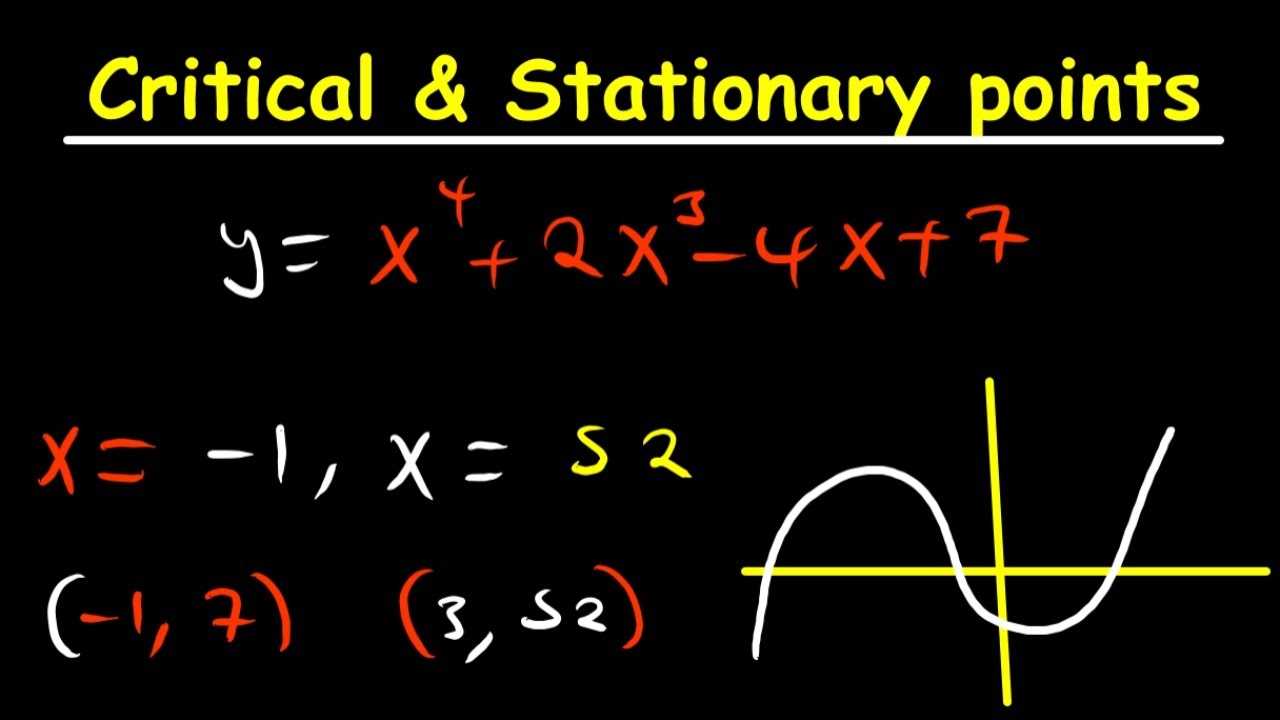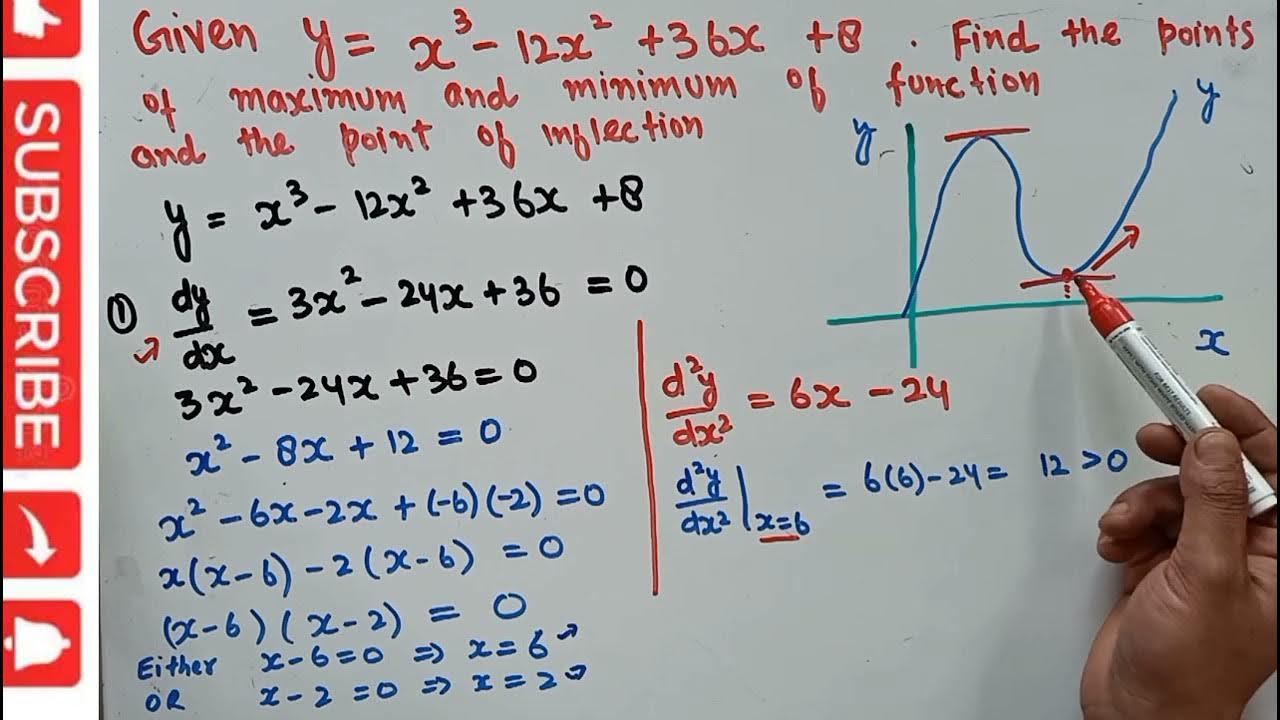Relative Maxima/Minima Examples
TLDRThe video script focuses on understanding and identifying various types of critical points in calculus, specifically relative maxima, minima, and horizontal points of inflection. The instructor explains the concept of a relative maximum as a point higher than its surroundings and a relative minimum as a point lower than its surroundings, using visual representations to aid understanding. The process involves finding the derivative of a function, setting it equal to zero to find critical points, and then using test points to determine intervals of increase and decrease. The script also covers how to identify horizontal points of inflection where the derivative equals zero but there is no change in the direction of the function's increase or decrease. The instructor provides step-by-step examples using two functions, f(x) = x^3 - 3x and g(x) = x^4 - x^3, to illustrate how to find and interpret these critical points. The summary emphasizes the importance of visualizing the function's behavior through arrows and correctly interpreting the results to identify relative extrema and points of inflection.
Takeaways
- 📈 A relative maximum is a point that is higher than anything around it, like a peak.
- 📉 A relative minimum is a point that is lower than anything around it, similar to a valley.
- 🔍 To find relative maxima and minima, look for critical points where the derivative is zero or undefined.
- ↗️ At a relative maximum, the function goes from increasing to decreasing.
- ↘️ At a relative minimum, the function transitions from decreasing to increasing.
- 🔁 Horizontal points of inflection occur where the function's derivative equals zero, but the function's direction of increase or decrease does not change.
- 📊 Use a number line to plot critical points and test intervals with chosen test points to determine increasing or decreasing behavior.
- ➗ When finding critical points, factor out the greatest common factor to simplify the equation.
- 📐 The second derivative can be used to analyze the concavity of a function, which will be discussed in the next class.
- 📈 The interval of increase for a function can be determined by where the derivative is positive.
- 📉 The interval of decrease for a function is where the derivative is negative.
- 📍 For homework, students may be asked to list relative maxima and minima as (x, y) coordinates by plugging the x values of critical points into the original function.
Q & A
What is a relative maximum in the context of the given transcript?
-A relative maximum is a point on a function that is higher than any point around it, similar to the peak of a hill.
How does a relative minimum differ from a relative maximum?
-A relative minimum is a point on a function that is lower than any point around it, as opposed to a relative maximum which is higher.
What is a critical point in calculus?
-A critical point is a point on a function where the derivative is either zero or undefined. It often corresponds to a maximum, minimum, or inflection point.
What does it mean when a function goes from increasing to decreasing at a point?
-This indicates a relative maximum, as the function's rate of change goes from positive to negative at that point.
How can you identify a relative minimum without calculus?
-You can identify a relative minimum by observing that the function goes from decreasing to increasing at that point.
What is a horizontal point of inflection?
-A horizontal point of inflection is a point on a function where the derivative is zero, but the function's behavior changes from increasing to increasing or from decreasing to decreasing without a sign change in the derivative.
Why is it important to find the derivative of a function when analyzing its behavior?
-The derivative of a function provides information about the slope of the function at a given point, which can indicate whether the function is increasing or decreasing.
What is the process for finding relative maxima and minima?
-The process involves finding the derivative of the function, setting it equal to zero to find critical points, using a number line to organize these points, selecting test points within each interval defined by the critical points, and evaluating the sign of the derivative at these test points to determine the behavior of the function.
How does the sign of the derivative at a test point indicate the function's behavior?
-If the derivative at a test point is positive, the function is increasing; if it is negative, the function is decreasing.
What is the significance of a horizontal point of inflection on the graph of a function?
-A horizontal point of inflection indicates a change in the concavity of the function, where the function transitions from convex to concave or vice versa, without a sign change in the derivative.
How can you determine the y-coordinates of relative maxima and minima?
-You can determine the y-coordinates by plugging the x-values of the relative maxima and minima back into the original function.
Why is it recommended to factor out the greatest common factor when finding the derivative of a polynomial?
-Factoring out the greatest common factor simplifies the process of setting the derivative equal to zero and solving for critical points, making it easier to analyze the function's behavior.
Outlines
📈 Understanding Relative Maxima and Minima
The first paragraph introduces the topic of finding relative maxima and minima, as well as critical points in calculus. It explains that a relative maximum is a point higher than its surroundings, like a peak, while a relative minimum is a point lower than its surroundings. The concept of critical points is introduced, where the derivative equals zero, indicating a horizontal tangent. The paragraph also discusses how to identify these points by observing changes from increasing to decreasing or vice versa. Additionally, it touches upon horizontal points of inflection, which occur when there's no change in the direction of the function's increase or decrease. The process of finding these points involves creating a number line, plotting critical points, and using test points to determine intervals of increase and decrease.
📚 Application of Derivatives to Identify Extrema
The second paragraph delves into the application of derivatives to find relative maxima and minima. It demonstrates the process by using the function f(x) = x^3 - 3x as an example. The derivative of the function is found, and critical points are determined by setting the derivative equal to zero. The process involves factoring out common terms and solving for x. Test points are chosen, and the derivative is evaluated at these points to ascertain whether the function is increasing or decreasing in different intervals. The results are visualized using arrows to represent the direction of the function's change. The paragraph concludes with the interpretation of the results, identifying the function's intervals of increase and decrease, as well as its relative extrema.
🔍 Further Exploration of Critical Points and Function Behavior
The third paragraph continues the exploration of critical points using the function g(x) = x^4 - x^3 as an example. The derivative of this function is calculated, and the greatest common factor is factored out to simplify the equation. The critical points are found by setting the derivative equal to zero. These points are then plotted on a number line, and test points are selected to determine the behavior of the function in different intervals. The derivative is evaluated at these test points to understand whether the function is increasing or decreasing. The results are interpreted to identify the intervals of increase and decrease and to determine if there are any relative extrema. The paragraph also explains how to find the y-values associated with relative maxima and minima by plugging the x-values back into the original function.
📉 Identifying Relative Minima and Points of Inflection
The fourth paragraph concludes the discussion by identifying a relative minimum at x = 3/4 for the function g(x) and a horizontal point of inflection at x = 0. It explains that a relative minimum occurs where the function transitions from decreasing to increasing, while a horizontal point of inflection is where the function maintains the same direction of change (either increasing or decreasing). The paragraph provides a visual representation of the function's graph, highlighting the behavior at critical points and the overall shape of the graph. It also mentions that the second derivative will be discussed in the next class, providing a preview of further topics to be covered.
Mindmap
Keywords
💡Relative Maxima
💡Relative Minima
💡Critical Points
💡Derivative
💡Horizontal Tangent Line
💡Number Line
💡Test Points
💡Intervals of Increase and Decrease
💡Horizontal Points of Inflection
💡Factoring
💡Second Derivative
Highlights
The concept of relative maxima and minima is introduced as points that are higher or lower than their surroundings, respectively.
Relative maxima are identified as points where the function changes from increasing to decreasing, while relative minima are where it changes from decreasing to increasing.
Critical points are defined as points where the derivative is zero or undefined, with the function never being undefined in the given example.
The process of finding relative maxima and minima involves setting the derivative equal to zero and solving for x, identifying potential extrema.
A number line is used to organize critical points and test points to determine intervals of increasing and decreasing functions.
Test points are chosen from different intervals to evaluate the sign of the derivative, indicating the direction of the function's change.
Visual aids like arrows are used to represent the function's behavior, with upward arrows for increasing and downward for decreasing.
The function's intervals of increase and decrease are determined by the sign of the derivative.
Relative extrema are located at points where the function's behavior changes from increasing to decreasing or vice versa.
If the function's behavior does not change at a critical point, it is called a horizontal point of inflection.
The derivative of the function f(x) = x^3 - 3x is calculated, and critical points are identified by setting it to zero.
The function g(x) = x^4 - x^3 is introduced, and its derivative is found by applying the power rule.
The greatest common factor is factored out from the derivative to simplify the equation and find critical points.
Test points are selected from different intervals to determine the behavior of the function g(x) = x^4 - x^3.
The function's intervals of increase and decrease are identified, and a relative minimum is found at x = 3/4.
A horizontal point of inflection is identified at x = 0 for the function g(x) = x^4 - x^3.
The process of finding relative maxima, minima, and points of inflection is demonstrated through step-by-step examples.
The importance of plugging test points into the derivative to determine the function's behavior is emphasized.
The lecture concludes with a summary of the process and a teaser for the next class, which will cover the second derivative and its implications.
Transcripts
Browse More Related Video

Fiding Relative Max, Min and Inflection Point with Derivatives F4

Graphing a Polynomial Equation :: Curve Sketching Using Calculus

Critical points & Stationary points

3.1 - Using First Derivatives to Classify Max and Min Values

Maxima , minima and point of inflection

Finding Absolute Maximum and Minimum Values - Absolute Extrema
5.0 / 5 (0 votes)
Thanks for rating: